

 Party People: Docudrama.
Party People: Docudrama.  Party People: Docudrama. By Universes (Steven Sapp, Mildred Ruiz-Sapp, William Ruiz). Directed by Liesl Tommy. Through Nov. 16. Berkeley Rep’s Thrust Stage, 2025 Addison St., Berkeley. Two hours, 40 minutes. $29-$89, subject to change. (510) 647-2949. www.berkeleyrep.org.
Party People: Docudrama. By Universes (Steven Sapp, Mildred Ruiz-Sapp, William Ruiz). Directed by Liesl Tommy. Through Nov. 16. Berkeley Rep’s Thrust Stage, 2025 Addison St., Berkeley. Two hours, 40 minutes. $29-$89, subject to change. (510) 647-2949. www.berkeleyrep.org.
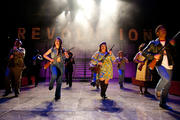
http://www.tcg.org/publications/at/issue/exec.cfm?indexID=24
 From the Executive DirectorThe Ripple Effect Teresa Eyring Early this fall I visited Oregon Shakespeare Festival, where I had the pleasure of immersing myself in that venerable company’s wide-ranging repertoire. Six plays were performing at the time, including three Shakespeares; an entertaining mash-up of Medea, Macbethand Cinderella; and a new play based on LBJ’s 1964 election and the fight for civil rights for African Americans. But for me, it was the sixth production that truly drove home the lesson that a theatre piece can branch out on multiple levels to touch not only the community where it’s playing but audiences near and far, even those who may not have actually seen the performance. “The play’s the thing,” all right, but the play may also be just the tip of the iceberg. The show I’m speaking of was Party People, a multimedia piece created by the New York–based ensembleUniverses, which used music, spoken word and dance to reexamine a controversial episode in our cultural history—the rise and fall in the 1960s and ’70s of the Black Panthers and Young Lords. The show spotlights the activism of these two outlaw entities, both of which sponsored important social programs, such as before-school breakfast and health care, in their impoverished communities. Party People also uncovered some of the internal strife that existed as the movements were dismantled, in part through the infiltration of police and government informants. In order to create the piece, commissioned by OSF as part of its American Revolutions history project, the Universes ensemble spent three years interviewing members of the Black Panthers and Young Lords. Immediately following the performance I attended, Steven Sapp, Mildred Ruiz and William “Ninja” Ruiz stayed on for a conversation with the audience. The room was packed with a multigenerational, racially diverse group representing a variety of political and social viewpoints. OSF is a “destination theatre,” so many of the attendees were visiting from other cities. Students from a San Francisco high school urged Universes to bring the piece to their school. As teens, they felt distanced from the historical moment of the play, but they also found its messages resonating with our times and their lives. One audience member expressed concern about the play’s suggestion that revolution is what’s needed in our society today—isn’t this, he queried, just a small step away from anarchy? There was a scholar present who asserted that the Universes artists, because of the depth and breadth of their research, are now the leading experts on the living history of the Panthers and Lords. (It’s inspiring to hear how artists can serve as experts and thought leaders on major topics of our times.) Another young person raised his hand and asked, “If there was one thing you want us to take away from this show, what would it be?” The artists’ valuable answer: First,read—it’s important to read everything you can and stay informed about the world around you. Second, remember change is accomplished in the small things you do, right in your own neighborhood—picking up trash on a particular street, helping someone you know in need. As the post-show conversation drew to a close, about a third of the hands in the room were still waving, eager to take the floor—evidence, for me, of the show’s emphatic ripple effect in the Ashland com-munity and beyond. I was driven the next day to the airport by the shuttle company owner—a grandmother—who told me what she was learning about the plays at OSF, and about the world at large, just by doing airport runs. Among her recent passengers, remarkably, were aging members of the Black Panthers and Young Lords who had flown to Ashland to see the play. The driver’s experience was enriched by the direct conversations she had with them about their lives and their reactions to the work onstage. While the historical period addressed in Party People is 1967 and beyond, All the Way by Robert Schenkkan deals with the 1964 election of Lyndon B. Johnson and the complicated politics around race at that time. And so another ripple took shape in the interaction between the plays themselves, as they generated reflections among spectators about a complex time in our sociopolitical history. Now we’re in another time of change—one in which we need to recognize the potential our theatres have to affect the world around them, through the work itself and through the currents that theatres, artists and plays can send through a community and far beyond. In this issue of American Theatre you’ll find coverage of Theatre Facts 2011, highlighting the fiscal strengths and weaknesses that currently characterize the field. Once again, subscription numbers have caught the attention of some members of the media, and Jonathan Mandell’s article reveals the latest thinking on ticketing practices—from the overwhelming fatigue that is felt by some because of the perennial focus on subscriptions, to the pressing need, voiced by TCG managing director Kevin Moore, for multiple strategies that recognize different audience needs. As Party Peopledemonstrated at OSF, we can expand our thinking—not just about how audiences are brought into our theatres, but about how powerful and multidimensional the relationship can be between the plays we produce and the communities in which we live.
From the Executive DirectorThe Ripple Effect Teresa Eyring Early this fall I visited Oregon Shakespeare Festival, where I had the pleasure of immersing myself in that venerable company’s wide-ranging repertoire. Six plays were performing at the time, including three Shakespeares; an entertaining mash-up of Medea, Macbethand Cinderella; and a new play based on LBJ’s 1964 election and the fight for civil rights for African Americans. But for me, it was the sixth production that truly drove home the lesson that a theatre piece can branch out on multiple levels to touch not only the community where it’s playing but audiences near and far, even those who may not have actually seen the performance. “The play’s the thing,” all right, but the play may also be just the tip of the iceberg. The show I’m speaking of was Party People, a multimedia piece created by the New York–based ensembleUniverses, which used music, spoken word and dance to reexamine a controversial episode in our cultural history—the rise and fall in the 1960s and ’70s of the Black Panthers and Young Lords. The show spotlights the activism of these two outlaw entities, both of which sponsored important social programs, such as before-school breakfast and health care, in their impoverished communities. Party People also uncovered some of the internal strife that existed as the movements were dismantled, in part through the infiltration of police and government informants. In order to create the piece, commissioned by OSF as part of its American Revolutions history project, the Universes ensemble spent three years interviewing members of the Black Panthers and Young Lords. Immediately following the performance I attended, Steven Sapp, Mildred Ruiz and William “Ninja” Ruiz stayed on for a conversation with the audience. The room was packed with a multigenerational, racially diverse group representing a variety of political and social viewpoints. OSF is a “destination theatre,” so many of the attendees were visiting from other cities. Students from a San Francisco high school urged Universes to bring the piece to their school. As teens, they felt distanced from the historical moment of the play, but they also found its messages resonating with our times and their lives. One audience member expressed concern about the play’s suggestion that revolution is what’s needed in our society today—isn’t this, he queried, just a small step away from anarchy? There was a scholar present who asserted that the Universes artists, because of the depth and breadth of their research, are now the leading experts on the living history of the Panthers and Lords. (It’s inspiring to hear how artists can serve as experts and thought leaders on major topics of our times.) Another young person raised his hand and asked, “If there was one thing you want us to take away from this show, what would it be?” The artists’ valuable answer: First,read—it’s important to read everything you can and stay informed about the world around you. Second, remember change is accomplished in the small things you do, right in your own neighborhood—picking up trash on a particular street, helping someone you know in need. As the post-show conversation drew to a close, about a third of the hands in the room were still waving, eager to take the floor—evidence, for me, of the show’s emphatic ripple effect in the Ashland com-munity and beyond. I was driven the next day to the airport by the shuttle company owner—a grandmother—who told me what she was learning about the plays at OSF, and about the world at large, just by doing airport runs. Among her recent passengers, remarkably, were aging members of the Black Panthers and Young Lords who had flown to Ashland to see the play. The driver’s experience was enriched by the direct conversations she had with them about their lives and their reactions to the work onstage. While the historical period addressed in Party People is 1967 and beyond, All the Way by Robert Schenkkan deals with the 1964 election of Lyndon B. Johnson and the complicated politics around race at that time. And so another ripple took shape in the interaction between the plays themselves, as they generated reflections among spectators about a complex time in our sociopolitical history. Now we’re in another time of change—one in which we need to recognize the potential our theatres have to affect the world around them, through the work itself and through the currents that theatres, artists and plays can send through a community and far beyond. In this issue of American Theatre you’ll find coverage of Theatre Facts 2011, highlighting the fiscal strengths and weaknesses that currently characterize the field. Once again, subscription numbers have caught the attention of some members of the media, and Jonathan Mandell’s article reveals the latest thinking on ticketing practices—from the overwhelming fatigue that is felt by some because of the perennial focus on subscriptions, to the pressing need, voiced by TCG managing director Kevin Moore, for multiple strategies that recognize different audience needs. As Party Peopledemonstrated at OSF, we can expand our thinking—not just about how audiences are brought into our theatres, but about how powerful and multidimensional the relationship can be between the plays we produce and the communities in which we live.
April 26, 2013
By Kate Dobbs Ariail
in Theater reviews
PlayMakers Repertory Company is wrapping up an intense year with a fascinating PRC2 presentation by the theatrical troupe Universes, in the Kenan Theatre. April 24 saw the world premiere of Spring Training, co-commissioned by PRC and Carolina Performing Arts as part of The Rite of Spring at One Hundred project. Since Universes is neither a dance company, a traditional theater company nor a traditional music ensemble, but a group that uses theatricality to fuse poetry and politics with mouth and body music, the result of their investigation of The Rite of Spring is quite different from any we’ve seen or heard during this extended Spring season. Chay Yew, artistic director of Chicago’s Victory Gardens Theatre, guided and directed this production.
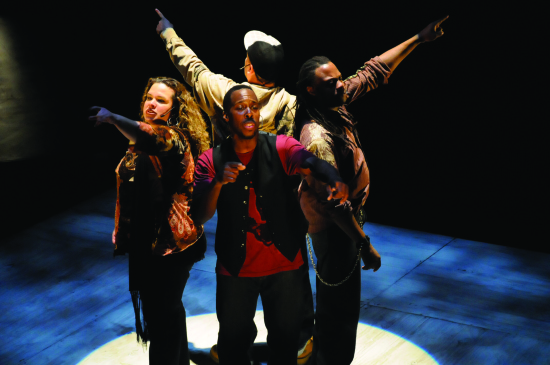
The troupe Universes, at PRC2 through April 28, with the commissioned work SPRING TRAINING. Photo courtesy PRC.
Spring Training opens with the well-known notes played by the bassoon–but here sung by Mildred Ruiz-Sapp, as her cohorts commence creating a layered set of rhythms. The music they make with vocalizations and body-beats is fantastic, and the complex rhythms and counter-rhythms are quite Stravinsky-esque. For a few moments, it seems that this will be a musical performance. But soon the stories begin, and four characters appear from the words. They do not initially seem connected, except by the tissue of rhythm and chorus in which they nestle, but commonalities emerge. They are stories of people struggling in the the spring of their lives, and reflecting on that “spring training” in their latter days. In each story, there is something about community, and something about wisdom from the elders. And in each story, there is death.
One notable thing among the many that set this Rite apart is the absence of the idea of sacrifice. In the original Stravinsky/Nijinsky/Roerich music/ballet/visualization, and in most of the subsequent dance versions, the Chosen One is sacrificed by the community for its ongoing good, and she acquiesces in that, as it is her community, too. InSpring Training, death is not so methodical or purposeful. A random drive-by shooting has no renewing effect. In one story, a man tries to get his family to safety when a riot breaks out in his own neighborhood. His car is stopped by the mob; he proves his solidarity by shouting out “let the motherfucker BURN” and they let him pass. This soundeth not like springtime, pagan or otherwise.
Shifting the focus toward the individuals within the community–to each of us dancing to the death–and the painful acquisition of wisdom while surviving life really flipsThe Ritearound. I’ve lost track of how many versions I’ve seen and heard since the inception of CPA’s project last September, but none of them has made me so completely reconsider the whole matter. Now that’s art.
Spring Training continues in the Kenan Theatre of the UNC Center for Dramatic Art, Chapel Hill, only through April 28 (two shows on Sunday). This is the small theatre–reservations recommended.http://www.playmakersrep.org
http://dctheatrescene.com/2010/10/25/ameriville/
Ameriville OCTOBER 25, 2010 BY BEN DEMERS Moments of great strife in American history, from the Civil War, to the Great Depression, to 9/11, have wrought considerable pain, suffering, and sadness, while inspiring some of our greatest and most vital works of art. In their explosive, moving Ameriville, theater collective Universes utilizes the prism of Hurricane Katrina to explore forgotten corners of our fractured American landscape, ultimately painting a dire, yet hopeful vision of our struggling nation.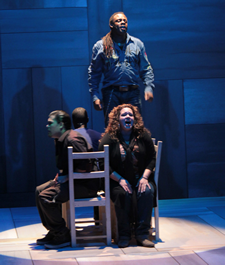
William Ruiz (A.K.A. “Ninja”), Gamal Chasten, Steven Sapp, and Mildred Ruiz (Photo: Danisha Crosby)
Now playing at Round House Theatre in Bethesda, Ameriville takes a pointed look at the current state of America through a fluid, energetic blend of spoken word, song, and dance. Each of Universes’ four members rotate through narrating duties, commenting on race relations, poverty, disaster relief, and tradition. Before sitting down to write the play, Universes lived in New Orleans, soaking up the history and culture and interviewing countless residents. As a result of their attention to detail and real investment in the lives of everyday people, their staging boasts a diverse spectrum of believable, relateable characters. Street vendors, children, tourists, barbers, hustlers, musicians, and others all come to life in Universes’ breathing portrait of a city and a nation on the mend. The dynamic script and spirited performances reveal a polished ensemble with undeniable writing and acting skills. The play is peppered with ingenious rhymes and vivid imagery, and the foursome’s relentless energy and careful pacing transforms a series of well-written pieces into a breathless, cohesive whole that keeps the audience on the edge of their seats for the duration of the show. Steven Sapp and Gamal Abdel Chasten inhabit a slate of memorable, complex characters, but perhaps their best moment comes during a hilarious display of rapid-fire one-upmanship. Each actor tries to prove he is “more black” than the other, lampooning widely-held stereotypes with an increasingly ridiculous string of hyperbole. Their natural talents, combined with their evident onstage rapport, make this scene a delight. William Ruiz, otherwise known as “Ninja”, proves himself quite the vocal chameleon, delivering captivating turns as a sleazy TV pitchman, a drunk Mardi Gras reveler harboring secret pain, and a child with some disturbing insights concerning human folly and cruelty throughout the ages. The musical component of the show is equally impressive. Universes creates a variety of sonic landscapes with just their voices, conjuring R & B, gospel, traditional, and salsa numbers with pitch-perfect a cappella and skillful beat-boxing from Ninja. The group uses musical numbers primarily as beats between scenes, using the repetition of phrases to establish a particular emotion or context. For example, Universes constantly turns to verses of “How high is the water…….3 feet high and risin’…..how high is the water……..5 feet high and risin’” to remind the audience of the flooding’s terrible, inexorable assault. Frequently, the group will mix in solos to flesh out a particular character or punctuate a scene. In a group loaded with musical talent, Mildred Ruiz-Sapp truly stands apart.With a gospel background and loads of natural ability, she sails through renditions of “House of the Rising Sun” and original solos across many styles, mixing in powerful belts and precise vocal runs to electrifying effect. The visual design bears mention as well. Well-conceived lighting choices, abstract image and video collages, and judiciously selected projections of New Orleans aid the performers in transporting the audience into their world and eliminate the need for extensive sets that might otherwise limit Universes’ movement and versatility. In fact, the group only utilizes a simple wooden table and four chairs throughout the entire performance. During the post-show talkback, Universes emphasized their group’s underlying goal to explore pressing social issues and to empower the audience to seek much needed change. In a cultural landscape dominated by awful reality television and the destructive 24-hour news cycle, this message has never seemed more vital. The show reminds us of the power of a small group of artists to make the audience reconsider their reality and ask “Is this good enough?”. Consider Ameriville required viewing.Ameriville By Universes Directed by Chay Yew Produced by Universes Theater Company, Inc. Reviewed by Ben Demers
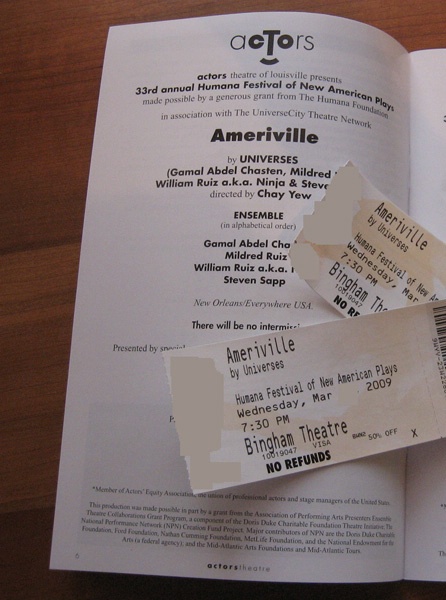
Ameriville Reviewed by Todd Zeigler theatrelouisville.org
Thank God for useful metaphors. Ameriville, the opening selection of the 2009 Humana Festival, is so much more than a typical play or musical. UNIVERSES, the quarter of creators/performers responsible for the 90-minute piece, use the full panoply of their talents to address the state of post-Katrina New Orleans in the broader context of the state of our union. Ameriville rolls along like moving water: it has myriad paces, pitches, volumes, tributaries, and when one reaches the mouth and sees the great expanse of the body, a sense of sublimity washes over. The piece opens with rhythm and song. The performers converge from the theatre's corners onto the stage, two tables and four chairs their only set pieces/props. Barely taking an eighth note to breathe, they weave a tapestry of the sounds, colors, and characters of New Orleans — and America. Many of the characters are familiar: the carnival barker, the voodoo lady, the old timers in the barber shop joking about the hardships they've endured. The group uses them as icons, posing questions and responses (not always answers) about how New Orleans is to cope with the tragedy — and the inequalities of all types exposed by the storm. Does health care really care? Is "urban renewal" just an indifferent euphemism for "nigger removal"? Why are the people of the United States so afraid of each other? The piece has a "compiled-from-interviews" feel similar to other contemporary dramatic works such as The Laramie Projectand last year's Humana entry, This Beautiful City. With this format comes the inherent risk of letting the interview material do all the work. It's not clear how much of Ameriville is compiled and how much is UNIVERSES' creation. The group brings the entirety of the subject matter to life with engrossing rhythms, song, and multimedia that keep the show jumping. Another evolution beyond similar works,Ameriville doesn't merely dwell on our problems. It envisions answers. The piece closes with visions of divided peoples forming a new whole, a city for all called Ameriville. The moods, modes, and rhythms that opened the show come full circle to a thrilling conclusion. This review is shorter than most, principally because it is difficult to put into words impressions that are so thoroughly rooted in mood.Ameriville is an experience on many levels: percolating, bubbling, and broiling, flooding the Bingham theatre to the very last row. Hold your breath and dive in.

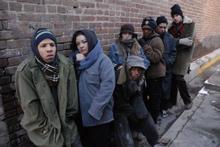
Photo by Michael Ensminger
Cast members in Curious Theatre Company's The Denver Project dress like people on Denver's streets. A young woman who goes by "Angel" was telling her story to Steve Sapp. She'd been a teenage prostitute and drug user, clean for one year and now living in a safe house provided by Providence Network. Sapp and his wife, Mildred Ruiz, were trying to learn something about what it means to be homeless in Denver in preparation for their new play, The Denver Project. "So how do you feel about us trying to write a play?" asked Sapp, his eyes smiling and his face framed by dreadlocks fringed with gray. Angel suggested a story line. "Maybe a lost girl who only knows men, and maybe she finds her way. I don't know if you're going to use God in her play," said Angel, 23, who had found God through Providence. "You tell me, what challenges do women face that men don't face?" asked Dee Covington, who would direct the play commissioned by Curious Theatre Company. "We struggle a lot more with emotions," Angel answered. "Do you guys believe in God?" Covington and Sapp nodded. "Yeah, you're good here," Covington said to Angel. A different approach Sapp and his wife have made their career taking theater into unfamiliar corners. Their theater company, Universes Poetic Theatre Ensemble, is based in the South Bronx, about five miles and a light year from Times Square. Rather than traditional scripts, they blend music, spoken-word poetry and movement in a style the two have evolved since they met at Bard College more than 20 years ago. The couple first worked with Curious two years ago, when they contributed a scene to The War Anthology. Artistic director Chip Walton suggested they work together again, which resulted inThe Denver Project, a leap from the usual narrative-based Curious project. "We fuse a lot of things together, so we kind of are bringing our Universes aesthetic into working with this company," Ruiz says. Over the past year, Sapp and Ruiz not only researched the lives of homeless people in Denver, they worked with Curious actors through a number of workshops. Some caught on immediately; others "really didn't get it," Sapp says. "In their minds, it's this hip-hop thing from New York. Strip all this stuff away, and we're just artists." A lifetime of drugs A few blocks from the women's safe house, Sapp visits a men's residence, where "Shawn," a Houston native, has been staying. Since getting busted for a huge quantity of LSD in his teens, Shawn has been in and out of group homes and rehab. He overdosed in Virginia with a crack pipe in his mouth and a needle in his arm, he says. He got sober, but then found out his sponsor was using drugs. At the same time, Shawn suffered from epilepsy and had regular seizures. Now 34, he'd been in the home for a month when he met Sapp. "I have twin boys that I haven't held in my arms since they were born," Shawn said. "I don't even know where they're at. I just know they're in Texas." Behind the project The Denver Project incorporates poetry, gospel and jazz, interspersed with the central story of a man intent on dressing up Denver's parking meters - in clothing - for the Democratic National Convention. His home is the street, and he wants it to look its best. In addition to meeting with Denver's homeless population, Ruiz and Sapp dove into the research. She read 10-year plans, studies and magazines. He rode the bus, walked the streets and sat in on a city committee meeting. "I sat there for three hours and watched all these people talk around a big table, and nothing was done," he says. The cast will look like Denver, with actors of different skin tones and different ages. Akil Luqman, who played young Simba in the national tour of The Lion King, joins the company. "There's a young kid in the play because there's a huge youth population here that's homeless," Sapp says. Learning the city "I'm not from Denver; I'm from New York, the South Bronx," Sapp told "Flower," another resident at Providence Network. "Every place is different, so I'm trying to get a sense of Denver. I just kind of roam around during the day and night. The first night I ever spent in Denver I ended up on Colfax and I thought, 'Oh good God, here's where the drama is.' " Flower knew plenty about Colfax. She'd lived there, using drugs and having sex for money, since leaving her mother's house. She and her friends called themselves Alley Kids, and they sustained themselves by dumpster diving. Flower knew that the best time to hit 7-Eleven was at 2 a.m., when she could score free food. Being a prostitute, she said, wasn't like a TV show. "We dressed in baggy pants. You're not walking down the street wearing high heels and short skirts. It's not like that," she explained. "The drugs are out there, and that makes life a lot easier when you're on the street. It kills the time, and you don't have to worry about where you're gonna sleep. Because if you're smoking, you're not sleeping." Sapp explains The Denver Project to Flower. "My wife and I don't do it traditional. It's not what we call on-the-couch plays. We're poets, and we're from the blocks, from the streets," he says. "The average person who goes to a play, what do you want them to hear, what do you want them to know?" "Everyone should be homeless for once in their life," Flower answers. "It can be sad; it can be funny."bornsteinl@RockyMountainNews.com or 303-954-5101
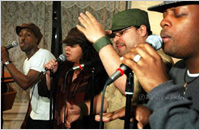

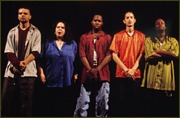
UNIVERSES Lemon, M. Ruiz, S. Sapp, F. Navaja and G. Chasten (Photo: Joan Marcus) |
One can only use the word "eclectic" to describe this unusual piece written and performed by Universes, a group of young artists from the South Bronx. Directed by Jo Bonney (most recently, References to Salvador Dali Make Me Hot), Slanguage is the kind of show that will catch you by surprise, snap you to attention and make you unable to suppress a laugh. Slanguage is more like an audio-visual collage than a theatrical piece. The five members of Universes bring together the music, movement and language of their background and playfully invite us in, allowing us to track the evolution of New York urban culture from the nursery rhymes of childhood to adult speech used in the streets. Universes' members are Gamal Abdel Chasten, Lemon, Flaco Navaja, Mildred Ruiz and Steven Sapp. Wearing bold primary colors the five evoke a rainbow of creativity. Chasten and Sapp are strong pillars in the group, keeping rhythm with percussion boxes at times, at others cleverly spitting out hip-hop and jazz infused poetry. Navaja and Lemon are visually softer and slight in frame, yet just as sharp-tongued and witty. Ruiz's powerful voice provides the backdrop of sound, and her tough female presence gives the group its balance. Slanguage evolves beautifully. To begin with we find ourselves on a subway ride that begins in Brooklyn and makes its way towards the Bronx. Along the way we are taken on detours, hilarious monologues and verbal jousting sessions that leave our brains ringing with the profusion of words. We might be told a story, for example, by Lemon, about the "war of slang", in which two local street gangs battle over their styles of language: First, you had the Willys... Famous for doubling up on their words Famous for talkin' that I need a jobby job On the really real But keep it on the lolo. Then you had the Willy What The Dealys From the North... That would end whatever they were saying... With you know what I mean and Ya heard me. We watch the group as they pretend to be children in the street, chanting rhymes and skipping rope, or as characters talking casually on a street corner. Like a lesson in slang, we learn everything from spanglish expressions like bochincheand jibaro to how "the bop walk" evolved. Within Slanguage are references to just about everything that has influenced this culture: Kung-Fu movies and the philosophy of Bruce Lee, the boleros and customs from Puerto Rico, stand-up comedians like Richard Pryor, Mohammed Ali, even Dr. Seuss. As Sapp puts it, "Another autobiography from at-risk agitators, assaulting and assembling articulation and alliteration, from Allah to Amos and Andy." Whether you feel like a true urban American or an absolute alien to this culture,Slanguage is a great experience. With amazingly accurate observation the performers show us what has come out of the mish-mash of cultures in this city's neighbourhoods. Even if you feel tragically disconnected with New York's colloquialisms, have no fear. Universes will attempt to explain it to you. Slanguage is for everyone from "big head bowlegged B-Boy brothers," to "Coons under concrete constellations…who can't even conceive the concept of coolness." (And if you're still stuck, there's a glossary provided in the playbill.)
